A Robust Power Allocation Algorithm for Cognitive Radio Networks Based on Hybrid PSO
Abstract
:1. Introduction
1.1. Previous Studies
1.2. Main Content and Arrangement
2. System Model
2.1. Robust Model
3. Hybrid PSO Algorithm for Power Allocation
3.1. PSO with Constraints
3.2. Adaptive Weighting Method
3.3. Natural Selection Algorithm
3.4. Hybrid PSO Algorithm
| Algorithm 1: Hybrid PSO algorithm for power allocation |
| 1. Set population parameters: |
| Initialize the number of particles, search space, maximum number of iterations, inertia weight, self-learning factor, group learning factor, set location speed limit. |
| 2. Generate initial population: |
| (1) Generate initial population location and speed. |
| (2) Initialize individual and group history best position. |
| (3) Initialize optimal fitness of individuals and groups. |
| 3. Particle swarm iteration: |
| (1) Update weights according to Formula (24). |
| (2) Update location and speed, and boundary handling. |
| (3) Make restriction judgments and calculate new fitness. |
| (4) Conduct natural selection processing: the particles are sorted according to the fitness, and the half good position is used to replace the other half bad position. |
| (5) Check to see whether the number of iterations is at its limit, then judge whether the output condition is reached. If the output result is reached, otherwise return to step 3. |
| 4. Output iteration results. |
4. Results
4.1. Performance Comparison
4.2. Other Performance of RAN- PSO Method
5. Conclusions
Author Contributions
Funding
Institutional Review Board Statement
Data Availability Statement
Conflicts of Interest
References
- Chen, S.Z.; Kang, S.L. A tutorial on 5G and the progress in China. Front. Inf. Technol. Electron. Eng. 2018, 19, 309–321. [Google Scholar] [CrossRef]
- Graydon, M.; Parks, L. ‘Connecting the unconnected’: A critical assessment of US satellite Internet services. Media Cult. Soc. 2020, 42, 260–276. [Google Scholar] [CrossRef]
- Giral, D.; Hernández, C.; Salgado, C. Spectral decision for cognitive radio networks in a multi-user environment. Heliyon 2021, 7, e07132. [Google Scholar] [CrossRef]
- Yuan, S.; Zhang, Y.; Qie, W.; Ma, T.; Li, S. Deep reinforcement learning for resource allocation with network slicing in cognitive radio network. Comput. Sci. Inf. Syst. 2021, 18, 979–999. [Google Scholar] [CrossRef]
- Liao, M. On optimal number of cognitive radios considering co-site electromagnetic compatibility. EURASIP J. Wirel. Commun. Netw. 2021, 2021, 1–16. [Google Scholar] [CrossRef]
- Kassri, N.; Ennouaary, A.; Bah, S.; Baghdadi, H. A Review on SDR, Spectrum Sensing, and CR-based IoT in Cognitive Radio Networks. Int. J. Adv. Comput. Sci. Appl. 2021, 12, 100–121. [Google Scholar] [CrossRef]
- Sun, S.; Ni, W.; Zhu, Y. Robust power control in cognitive radio networks: A distributed way. In Proceedings of the 2011 IEEE International Conference on Communications (ICC), Kyoto, Japan, 5–9 June 2011. [Google Scholar]
- Tuan, P.V.; Koo, I. Robust Weighted Sum Harvested Energy Maximization for SWIPT Cognitive Radio Networks Based on Particle Swarm Optimization. Sensors 2017, 17, 2275. [Google Scholar] [CrossRef]
- Xu, L.; Cai, L.; Gao, Y.; Xia, J.; Yang, Y.; Chai, T. Security-Aware Proportional Fairness Resource Allocation for Cognitive Heterogeneous Networks. IEEE Trans. Veh. Technol. 2018, 67, 11694–11704. [Google Scholar] [CrossRef]
- Yoo, S.-J.; Khan, H.; Kwak, K.-S. Dymamic MAC Frame Configuration and PSO-Based Optimal Resource Allocation in Multi-channel Cognitive Radio Ad-Hoc Networks. Wirel. Pers. Commun. 2019, 109, 595–620. [Google Scholar] [CrossRef]
- Pradhan, A.; Bisoy, S.K.; Das, A. A survey on PSO based meta-heuristic scheduling mechanism in cloud computing environment. J. King Saud Univ.-Comput. Inf. Sci. 2022, 34, 4888–4901. [Google Scholar] [CrossRef]
- Tang, M.; Long, C.; Guan, X.; Wei, X. Nonconvex dynamic spectrum allocation for cognitive radio networks via particle swarm optimization and simulated annealing. Comput. Netw. 2012, 56, 2690–2699. [Google Scholar] [CrossRef]
- Eappen, G.; Shankar, T.J.P.C. Hybrid PSO-GSA for energy efficient spectrum sensing in cognitive radio network. Phys. Commun. 2020, 40, 101091. [Google Scholar] [CrossRef]
- Yang, Y.; Zhang, Q.; Wang, Y.; Emoto, T.; Akutagawa, M.; Konaka, S. Adaptive resources allocation algorithm based on modified PSO for cognitive radio system. China Commun. 2019, 16, 83–92. [Google Scholar] [CrossRef]
- Wang, H.; Jiang, F.; Zhou, M. Cognitive radio power allocation algorithm based on improved particle swarm optimization. In Proceedings of the 16th IEEE International Conference on Communication Systems (IEEE ICCS), Chengdu, China, 19–21 December 2018. [Google Scholar]
- Gogoi, A.J.; Choudhury, H.A.; Baishnab, K.L. Swarm intelligence based optimization of energy consumption in cognitive radio network. J. Intell. Fuzzy Syst. 2019, 36, 2399–2407. [Google Scholar] [CrossRef]
- Wang, D.; Tan, D.; Liu, L. Particle swarm optimization algorithm: An overview. Soft Comput. 2018, 22, 387–408. [Google Scholar] [CrossRef]
- Harrison, K.R.; Engelbrecht, A.P.; Ombuki-Berman, B.M. Self-adaptive particle swarm optimization: A review and analysis of convergence. Swarm Intell. 2018, 12, 187–226. [Google Scholar] [CrossRef]
- Du, C.; Yin, Z.; Zhang, Y.; Liu, J.; Sun, X.-D.; Zhong, Y. Research on Active Disturbance Rejection Control with Parameter Autotune Mechanism for Induction Motors Based on Adaptive Particle Swarm Optimization Algorithm with Dynamic Inertia Weight. IEEE Trans. Power Electron. 2018, 34, 2841–2855. [Google Scholar] [CrossRef]
- Hop, D.C.; Van Hop, N.; Anh, T.T.M. Adaptive particle swarm optimization for integrated quay crane and yard truck scheduling problem. Comput. Ind. Eng. 2021, 153, 107075. [Google Scholar] [CrossRef]
- Guo, L.; Abdul, N.M.M. Design and evaluation of fuzzy adaptive particle swarm optimization based maximum power point tracking on photovoltaic system under partial shading conditions. Front. Energy Res. 2021, 9, 712175. [Google Scholar] [CrossRef]
- Sombat, A.; Saleewong, T.; Kumam, P. Perspectives and experiments of hybrid particle swarm optimization and genetic algorithms to solve optimization problems. In International Econometric Conference of Vietnam; Springer: Cham, Switzerland, 2018. [Google Scholar]
- Zhang, W.; Huang, G.; Wang, G.; Wang, Y. The Spectrum Allocation Technology Based on Hybrid Particle Swarm Optimization in Cognitive Communication. In IOP Conference Series: Materials Science and Engineering; IOP Publishing: Beijing, China, 2019. [Google Scholar]
- Xu, Y.; Yang, M.; Yang, Y.; Ye, Y.; Hu, R.Q.; Li, D. Max-Min Energy-Efficient Optimization for Cognitive Heterogeneous Networks with Spectrum Sensing Errors and Channel Uncertainties. IEEE Wirel. Commun. Lett. 2022, 11, 1113–1117. [Google Scholar] [CrossRef]
- Chen, W.; Liang, J.; Xiao, N.; Zhao, G.; Guo, Z. A Robust Power Control Algorithm with Priority of Energy Efficiency. J. Xi’an Jiaotong Univ. 2021, 55, 143–149. [Google Scholar]
- Lee, S.-H.; Shi, X.-P.; Tan, T.-H.; Tung, Y.-C.; Huang, Y.-F. Maximizing Channel Capacity of 3D MIMO System via Antenna Downtilt Angle Adaptation Using a Q-Learning Algorithm. Electronics 2022, 11, 1189. [Google Scholar] [CrossRef]
- Awad, H.; Bayoumi, E.; Soliman, H.; De Santis, M. Robust Tracker of Hybrid Microgrids by the Invariant-Ellipsoid Set. Electronics 2021, 10, 1794. [Google Scholar] [CrossRef]
- Paul, A.K.; Shill, P.C.; Rabin, R.I.; Murase, K. Adaptive weighted fuzzy rule-based system for the risk level assessment of heart disease. Appl. Intell. 2018, 48, 1739–1756. [Google Scholar] [CrossRef]
- Ai, B.; Dong, M. Improved particle swarm optimization algorithm based on Gaussian disturbance and natural selection. J. Comput. Appl. 2016, 36, 687. [Google Scholar]
- Li, Y.; Zhao, Y.; Liu, J. Dynamic sine cosine algorithm for large-scale global optimization problems. Expert Syst. Appl. 2021, 177, 114950. [Google Scholar] [CrossRef]
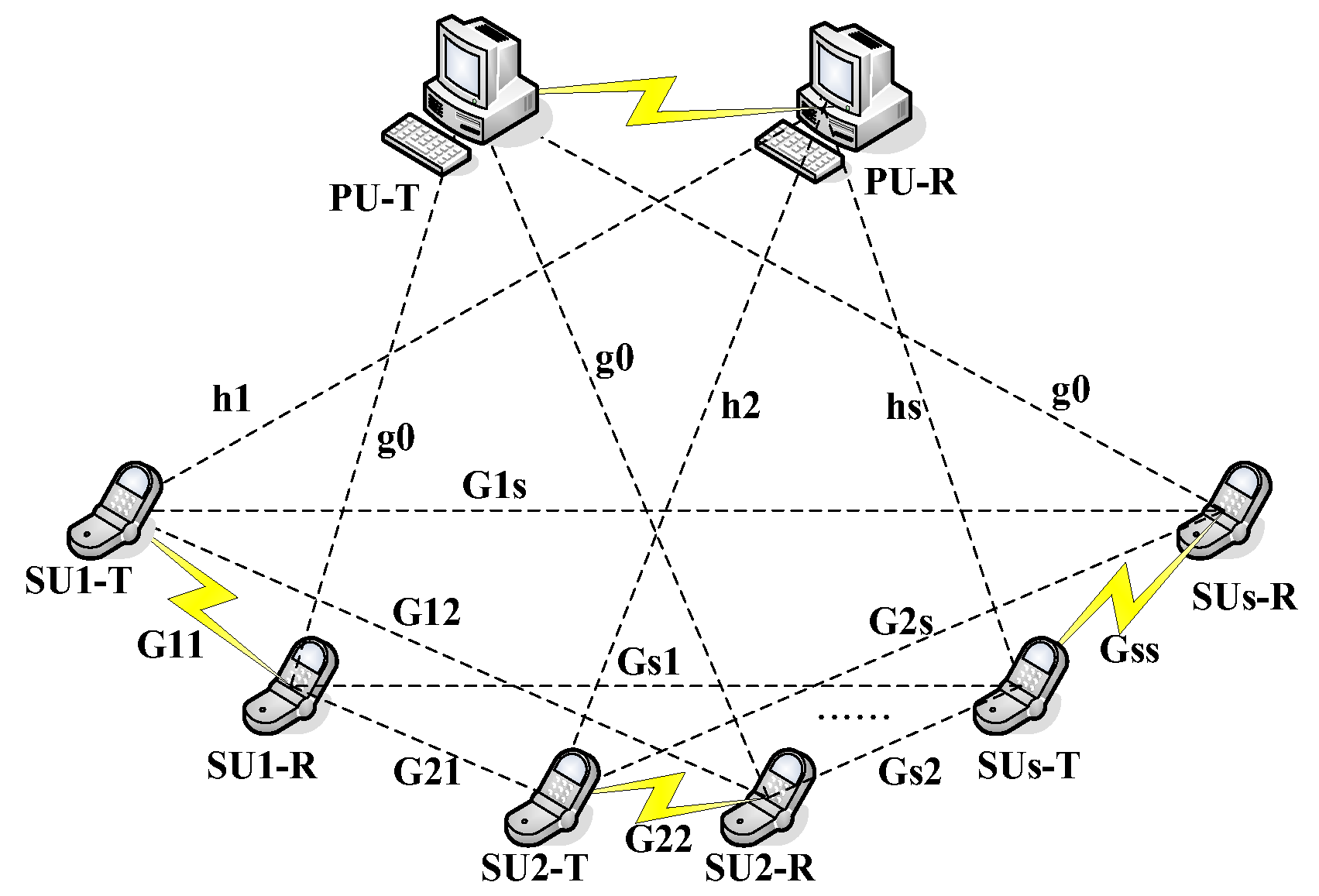

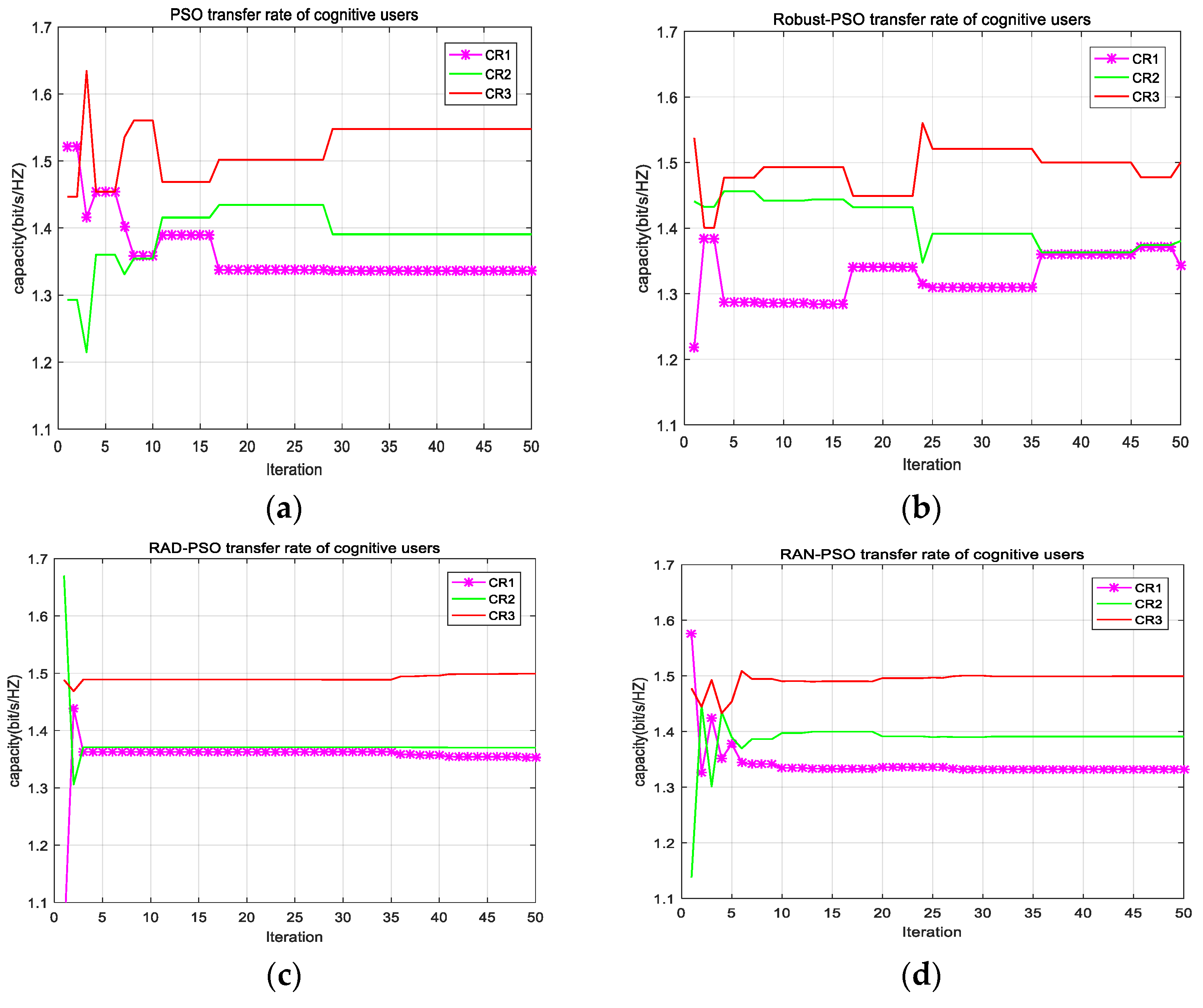
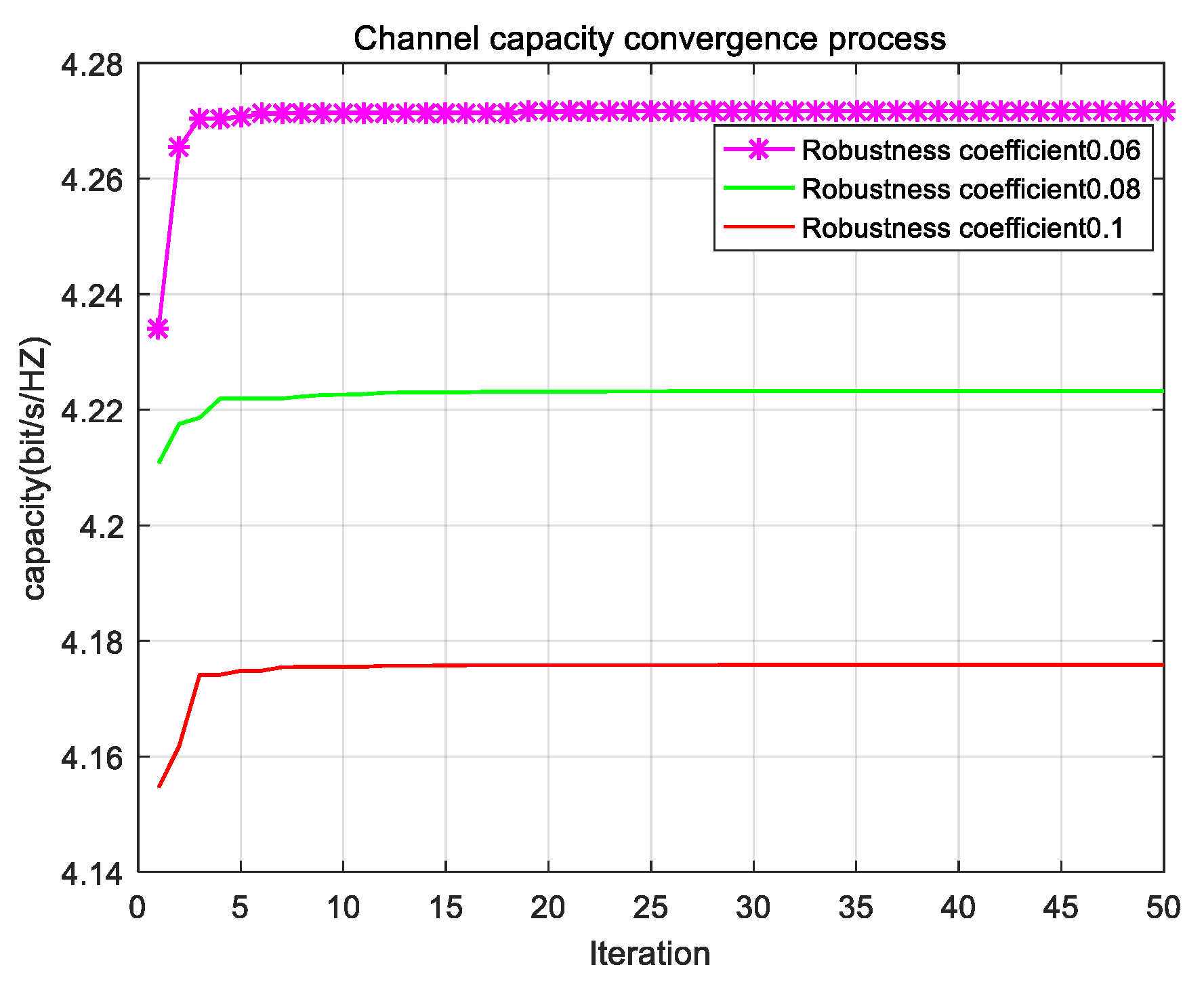

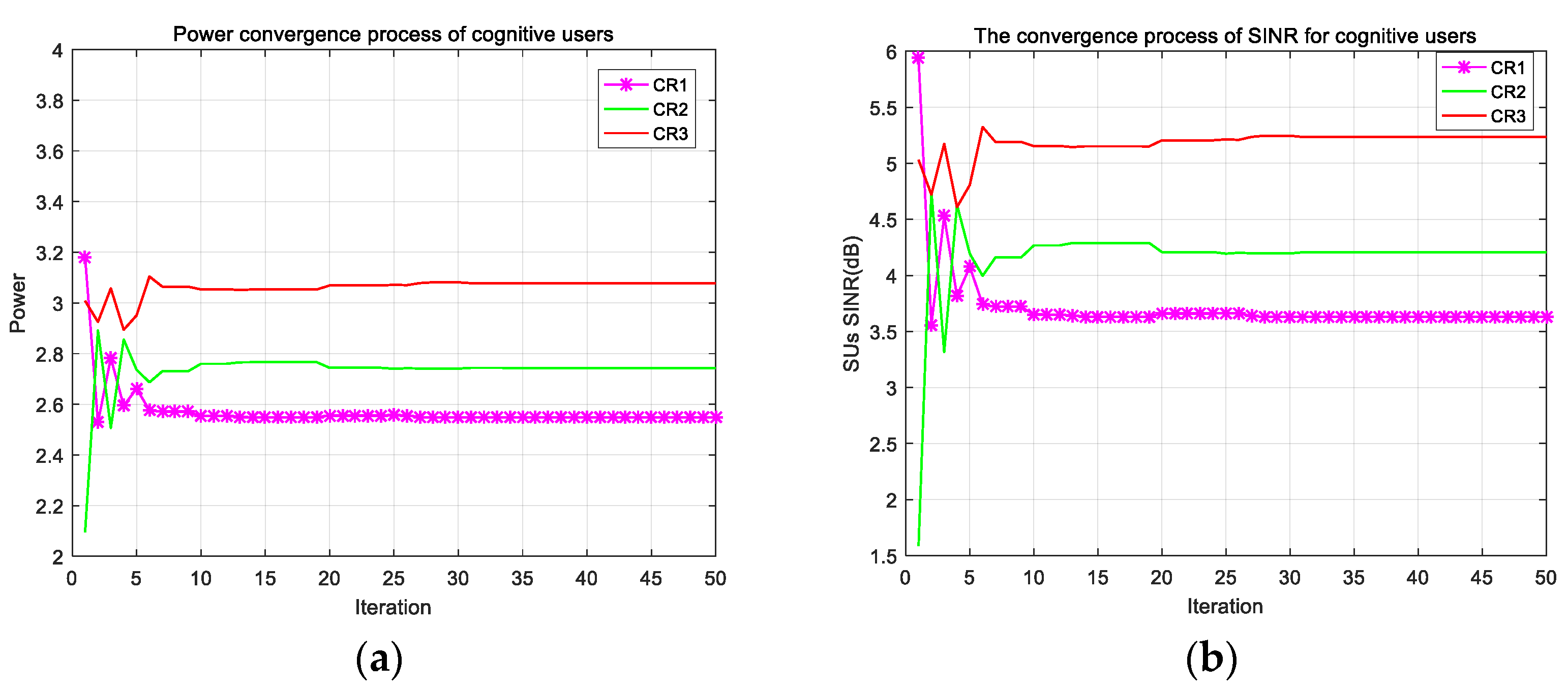
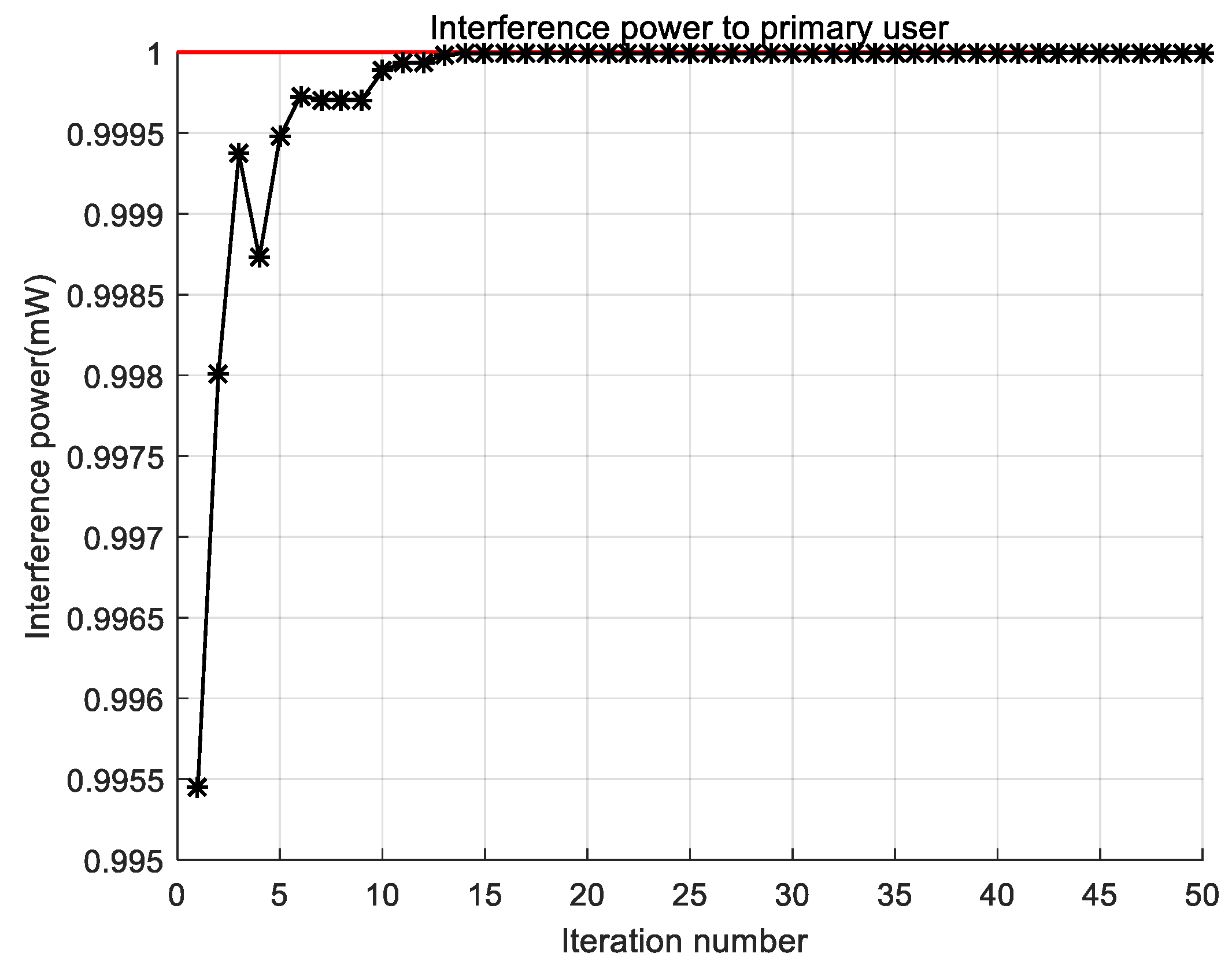
| Parameter | Size |
|---|---|
| Number of SU: | 3 |
| Number of PU: | 1 |
| Interference threshold of PU: | 1 mw |
| Robustness coefficient: | 0.08 |
| Maximum transmission power of SU: | 15 mw |
| transmission power of PU: | 20 mw |
| Background noise: | 0.1 mw |
| Transmission rate variance constraint of SU: | 0.1 |
| PSO | Robust-PSO | RAD-PSO | RAN-PSO | |
|---|---|---|---|---|
| Self-learning factor (c1): | 0.8 | 0.8 | 0.8 | 0.8 |
| Group learning factor (c2): | 0.8 | 0.8 | 0.8 | 0.8 |
| Inertia weight (w): | 0.8 | 0.8 | \ | \ |
| Population size: | 300 | 300 | 300 | 300 |
| Iterations: | 50 | 50 | 50 | 50 |
| Search space dimensions (D): | 3 | 3 | 3 | 3 |
| Inertia weight max (wmax): | \ | \ | 0.8 | 0.8 |
| Inertia weight min (wmin): | \ | \ | 0.6 | 0.6 |
Publisher’s Note: MDPI stays neutral with regard to jurisdictional claims in published maps and institutional affiliations. |
© 2022 by the authors. Licensee MDPI, Basel, Switzerland. This article is an open access article distributed under the terms and conditions of the Creative Commons Attribution (CC BY) license (https://creativecommons.org/licenses/by/4.0/).
Share and Cite
Zhao, L.; Zhou, M. A Robust Power Allocation Algorithm for Cognitive Radio Networks Based on Hybrid PSO. Sensors 2022, 22, 6796. https://doi.org/10.3390/s22186796
Zhao L, Zhou M. A Robust Power Allocation Algorithm for Cognitive Radio Networks Based on Hybrid PSO. Sensors. 2022; 22(18):6796. https://doi.org/10.3390/s22186796
Chicago/Turabian StyleZhao, Lu, and Mingyue Zhou. 2022. "A Robust Power Allocation Algorithm for Cognitive Radio Networks Based on Hybrid PSO" Sensors 22, no. 18: 6796. https://doi.org/10.3390/s22186796
APA StyleZhao, L., & Zhou, M. (2022). A Robust Power Allocation Algorithm for Cognitive Radio Networks Based on Hybrid PSO. Sensors, 22(18), 6796. https://doi.org/10.3390/s22186796





